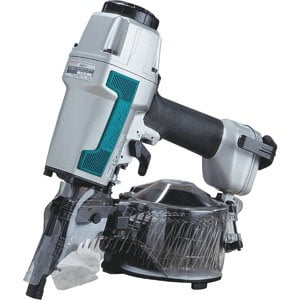Siding nailers have their own unique role in construction. They are the best tool for fastening wood shingles or fiber cement siding to the exterior of a home. They function a lot like a framing nailer but use smaller fasteners. And they usually have no-mar tips that won’t damage the wood. Let’s review two popular coil siding nailers to see which one is better for the work you want to do.
Makita AN611 1-1/4-Inch to 2-1/2-Inch Coil Siding Nailer

The Makita AN611 siding nailer comes with a transparent round magazine that holds up to 400 nails at a time. That’s a hundred more than the Hitachi nailer can handle. And the coiled design lets you work for longer periods before you need to reach for a refill.
The AN611 nailer accepts a range of sizes from 1-1/4 to 2-1/2-inch-long nails with 0.80 to 0.99-inch-diameter shanks. Then the only other requirement is that the nails are collated at 15-degrees with either wire or plastic.
You can control the way the nail gun fires with a selector switch located near the trigger. The switch allows you to lock the gun to prevent misfires, or you can choose between contact mode and sequential firing.
There’s also a depth control adjustment with nine depth settings. Each depth setting is 1/16-inch apart from the next. That means you don’t have to guess how to set a nail flush with the surface or estimate the force needed to countersink one.
You can switch between the no-mar tip and the clawed spurs depending on whether you need to protect the wood from damage. Either way, the gun’s format makes diagonal nailing a snap. Plus, the nailer has rubber bumpers in strategic places to avoid unwanted scratches.
Of course, Makita includes features typical of other nail guns. First, there is an air filter that keeps dust out of the inner workings. Next, the handle has a rubbery coating for better grip. And you can move the deflector to keep the exhaust from hitting you. But then there is also a pleasant addition that not every nailer has—a silent sheet. The sheet reduces the noise you hear when you disconnect the coupler.
More features of the Makita AN611 Coil Siding Nailer:
- Covered by a 5-year warranty
- Weighs 5 pounds
- Operates at 65 to 120psi
- Minimum recommended air delivery is 3.6 SCFM @ 90psi
- Comes with tool case, safety goggles, pneumatic nailer oil, hex wrench, reversible tool hook, and air fitting
Hitachi NV65AH2 Coil Siding Nailer, 2-1/2-Inch

Hitachi’s NV65AH2 Coil Siding Nailer weighs a little less than the Makita AN611, but it has many similar features. For example, both nail guns have actuation switches to simplify the change between contact and sequential firing. And both guns have tool-less depth of drive adjustment, too.
But unlike the previous nailer above, the Hitachi drives wire or plastic-collated nails from 1-1/2 to 2-1/2-inches in length, and between 0.090 and 0.099” in thickness. But it can sink up to three nails a second if the air pressure conditions are right. And the plastic shield deflects the used collation wire away from the user for safety.
Finally, the Hitachi NV65AH2 offers the flexibility of working with the no-mar nose cap or without it. And you can adjust the deflector to direct exhaust away from you.
More features of the Hitachi NV65AH2 Coil Siding Nailer:
- Covered by a 5-year warranty
- Weighs 4.8 pounds
- Recommended 70-120psi, 3/8” connector
- Holds up to 300 nails at a time
- Comes with safety glasses, hex wrenches, and no-mar nose tip
Recommendation
When choosing between the Hitachi and Makita coil siding nailers, there are a few key differences to notice. One is the size of the nails that they use. For example, the Makita AN611 can handle smaller, thinner nails as well as the largest ones that the Hitachi accepts. And the Makita has a larger side-loading magazine.
Next, the Hitachi weighs a little less than the Makita, and it comes with a longer warranty. But the Makita has some attractive details like a reversible tool hook, the sound dampening sheet, and the numbered depth adjustment. In conclusion, it’s a tough call between these two siding nailers.